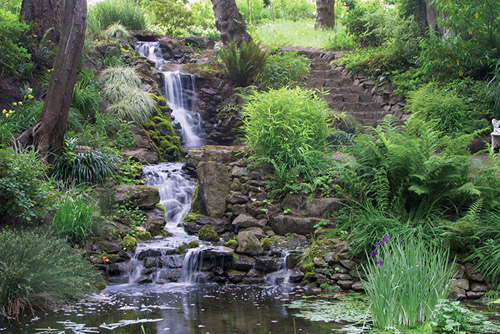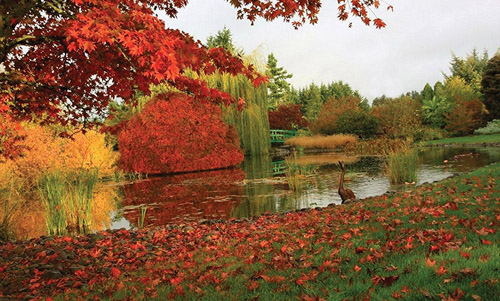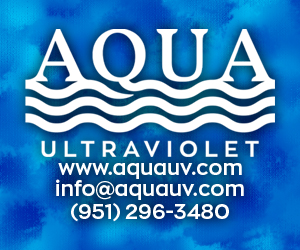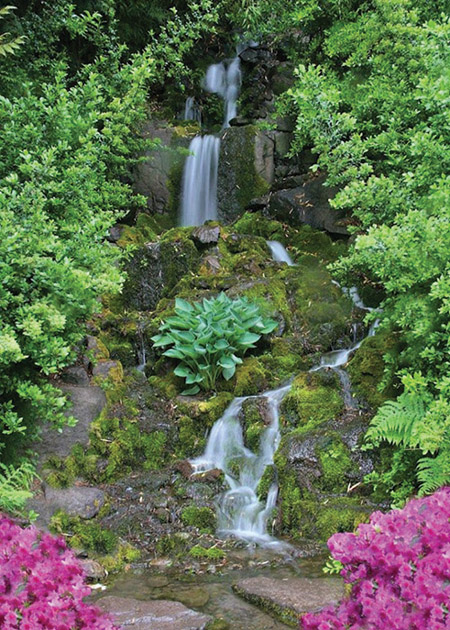
The sight and sounds of water in the landscape captivate our senses in a way that resonates deep within our souls. The movement of water in the garden washes away the stresses of daily life. After you’ve had a garden with a water feature in it, you will never again want a garden without one. This article is intended to show how the creative use of terrestrial plantings surrounding the water feature can address site problems and ensure that a new water feature appears naturally placed within the landscape.
I have been designing and constructing water features for almost 50 years. I love to create landscapes where the water feature blends seamlessly into the surrounding landscape. Sometimes this is relatively easy to do, because the terrain lends itself to a natural positioning of the feature. Other times, site conditions pose major difficulties and require a very creative design to fool the observer into believing that the feature has always existed there.These difficult sites include intrusive surrounding properties and difficult terrain, especially when the slope of the garden falls away from the main viewing areas. I sometimes joke with my clients that I have searched the internet for some “sloping water” to no avail, so we’ll just have to use the regular level stuff!
Natural Wonders
 The naturalizing of the water feature begins with proper placement within the contours of the area. Look to where water wouldnaturally flow and settle, and this will guide you to the best location. Once you have completed the excavation and grading, you need to place the rock for the waterfalls and surroundings. The effect you are trying to create is that over the eons, water has eroded away the bedrock and gouged out the waterfalls.
The naturalizing of the water feature begins with proper placement within the contours of the area. Look to where water wouldnaturally flow and settle, and this will guide you to the best location. Once you have completed the excavation and grading, you need to place the rock for the waterfalls and surroundings. The effect you are trying to create is that over the eons, water has eroded away the bedrock and gouged out the waterfalls.
The secret to good rock placement is to set it all in the same plane. This means that most of the rocks should have their strata lines generally lined up. If you do not do this, it will have the appearance of a pile of rocks dropped off by a dump truck. Each boulder and piece of rock needs to speak to each other and give the impression that they are all connected through the bedrock.The next phase of naturalization occurs around the edges of the pond and sometimes within the waterfalls. This is achieved using aquatic and bog-loving plants to soften the hard edges of the rocks. Be careful that the plants you choose are not invasive, or else they will cause damming problems as they grow and may block the water course.
Planting Tips
Once the immediate edges of the feature are planted, it’s time to address the surrounding landscape. Choose plant material that is native to your area or that which will blend well with the native flora.Layering these plants as you transition away from the pond’s edge creates a soft, natural flow upward and away from the water. Try to frame the waterfalls with some taller plants, like vine or Japanese maples. This framing creates the illusion of depth as though the falls are deeply recessed.
If the contours of the site are such that you must do some cut and fill to create a flat area for the pond, the planting takes on a vital role in the naturalization. Often the downward side of the supporting berm creates a steep dropoff beyond the pond. If you do not address this properly, the pond will appear perched up in the landscape and feel out of place. This issue can be resolved by heavily planting the slopes with evergreen shrubbery and trees. If possible, I also like to create enough of a flat area on top of the berm to allow for a walkway around the back of the pond. In the Pacific Northwest where I live and work, river birch is a great tree to help create this shaded walkway. These pathways also lend themselves to setting a small, secluded sitting area with a view across the pond.
The other major problem we come up against are elements on a neighboring property that would detract from creating a natural water feature. One of our toughest projects was for a client who wanted a swimming-hole effect pool that backed up to the poly houses of their plant nursery. The difficulty was in hiding the surrounding nursery to create a secluded oasis. I sourced beautiful, natural-moss boulders and constructed a shelf that would be 1 foot below the pool’s water level. This would allow the boulders to emerge from under the waterline, thus creating a more natural effect. The client, Dave Snodgrass, a prominent local landscaper, did an amazing job with the screening plants, and in a short time, you had no idea what was beyond the pool.  I then created the illusion that the pool flowed under a bridge. I constructed an outflow to a stream under the other side of the bridge, and this stream flows around the home to a large pond in the front garden.
I then created the illusion that the pool flowed under a bridge. I constructed an outflow to a stream under the other side of the bridge, and this stream flows around the home to a large pond in the front garden.
It is very important in your design to make sure that the new water feature and its surrounding landscape will look appealing in all seasons. Include a mix of shrubbery that will have year-round interest.
Spring-flowering azaleas will brighten the landscape early in the season. The summer palette of perennials such as rudbeckia and salvias give joy all summer. After the fall color show of Japanese maples and Euonymus alatus, winter will be brightened by the planting of a bank of Cornus Midwinter Fire, which will glow until spring arrives again.
Often you can use landscape from beyond the property you are designing. This “borrowed” landscape can be as simple as a tall backdrop of shrubs and trees. You can plant an understory of plants that will hide boundary fences and appear that all the landscape belongs around your water feature. If you are designing a garden with the backdrop of hills, you can make the new watercourse appear to have originated in the far-off hills.We often arrive at a new home to discover a lawn with some shrubs around the perimeter. We must create the client’s oasis on this stark palette. The first thing you may need to do is convince them to abandon their lawns. This is often a tough sell, but make sure they realize that a properly balanced pond will be much less maintenance in the long term versus grass. Water also makes the whole area seem larger; the reflections of neighboring trees in the water amplify the feeling that the garden is much bigger and more interesting. By planting the surroundings of the new feature with a broad selection of trees and shrubs, you will provide food and shelter for a new, biologically diverse habitat.
We are often hired to enhance dark, uninviting spaces. The addition of water will bring these gloomy areas to life, and they can transform into a lush oasis where you can spend time relaxing. I once designed a garden in a small woodland glade. I had to make sure that I followed the contours of the area to make it look like the waterfalls had eroded through the underlying rock as it flowed down to the pond. An access stairway was built down to the pond with a small sitting area set into the hillside. Then the surrounding landscape was enhanced with shade-loving native plants, which softened the whole feel.
Enhancing Ecosystems
 As I write this article, I look out from my home office window upon my large pond in wonderment at the teeming life that inhabits it. What was a bare, open field 12 years ago, is now a beautiful habitat. Swallows are skimming across the water as they drink. Dragon and damselflies of many colors are dipping and diving in their courtship dances above the water. A Pacific tree frog begins a short chorus. As water gardeners, we are truly blessed that we can create these environments.
As I write this article, I look out from my home office window upon my large pond in wonderment at the teeming life that inhabits it. What was a bare, open field 12 years ago, is now a beautiful habitat. Swallows are skimming across the water as they drink. Dragon and damselflies of many colors are dipping and diving in their courtship dances above the water. A Pacific tree frog begins a short chorus. As water gardeners, we are truly blessed that we can create these environments.



